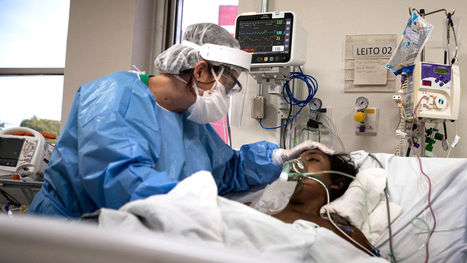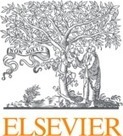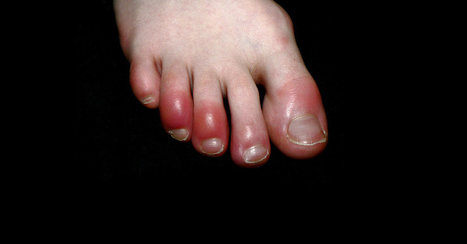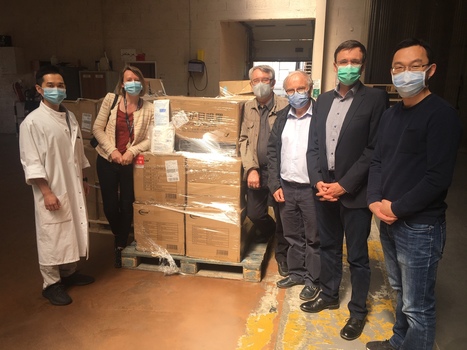 Your new post is loading...
 Your new post is loading...

|
Scooped by
Gilbert C FAURE
June 3, 2020 9:09 AM
|
Damage to vessel lining may drive mysterious clotting disorders, inflammation

|
Scooped by
Gilbert C FAURE
June 2, 2020 10:54 AM
|
Trois cents infections asymptomatiques par le nouveau coronavirus ont été découvertes lors de tests sur dix millions d'habitants de Wuhan, en Chine.

|
Scooped by
Gilbert C FAURE
May 28, 2020 3:48 AM
|

|
Scooped by
Gilbert C FAURE
May 23, 2020 7:01 AM
|
Gilbert Faure, a Community Story from France

|
Scooped by
Gilbert C FAURE
May 19, 2020 2:51 AM
|
This study describes results of IgM and IgG antibody testing from throat swabs of newborns born to mothers with COVID-19 pneumonia.

|
Scooped by
Gilbert C FAURE
May 15, 2020 7:08 AM
|

|
Suggested by
LIGHTING
May 14, 2020 9:13 AM
|
In the past month we found a 30-fold increased incidence of Kawasaki-like disease.
Children diagnosed after the SARS-CoV-2 epidemic began showed evidence of immune response
to the virus, were older, had a higher rate of cardiac involvement, and features of
MAS. The SARS-CoV-2 epidemic was associated with high incidence of a severe form of
Kawasaki disease. A similar outbreak of Kawasaki-like disease is expected in countries
involved in the SARS-CoV-2 epidemic.

|
Scooped by
Gilbert C FAURE
May 8, 2020 3:57 AM
|
some cellular immunity inside, with elispots...

|
Scooped by
Gilbert C FAURE
May 7, 2020 4:23 AM
|
SARS-CoV-2 is a SARS-like coronavirus of likely zoonotic origin first identified in December 2019 in Wuhan, the capital of China's Hubei province. The…

|
Scooped by
Gilbert C FAURE
May 6, 2020 1:41 PM
|
The coronavirus disease 2019 (COVID-19) pandemic, caused by Severe Acute Respiratory
Syndrome Coronavirus 2 (SARS-CoV-2) has affected millions of people worldwide, igniting
an unprecedented effort from the scientific community to understand the biological
underpinning of COVID19 pathophysiology. In this review, we summarize the current
state of knowledge of innate and adaptive immune responses elicited by SARS-CoV-2
infection and the immunological pathways that likely contribute to disease severity
and death.

|
Scooped by
Gilbert C FAURE
May 4, 2020 1:45 PM
|
Analyses from single-cell sequencing datasets support the idea that COVID-19 is not just a respiratory disease but an illness that can affect multiple organs.

|
Rescooped by
Gilbert C FAURE
from Virus World
May 2, 2020 1:39 PM
|
Dermatologists say the lesions should prompt testing for the virus, even though many patients have no other symptoms. Before the coronavirus outbreak, Dr. Lindy Fox, a dermatologist in San Francisco, used to see four or five patients a year with chilblains — painful red or purple lesions that typically emerge on fingers or toes in the winter. Over the past few weeks, she has seen dozens. “All of a sudden, we are inundated with toes,” said Dr. Fox, who practices at the University of California, San Francisco. “I’ve got clinics filled with people coming in with new toe lesions. And it’s not people who had chilblains before — they’ve never had anything like this.” It’s also not the time of year for chilblains, which are caused by inflammation in small blood vessels in reaction to cold or damp conditions. “Usually, we see it in the dead of winter,” Dr. Fox said. Dr. Fox is not the only one deluged with cases. In Boston, Dr. Esther Freeman, director of global health dermatology at the Massachusetts General Hospital, said her telemedicine clinic is also “completely full of toes. I had to add extra clinical sessions, just to take care of toe consults. People are very concerned.” The lesions are emerging as yet another telltale symptom of infection with the new coronavirus. The most prominent signs are a dry cough and shortness of breath, but the virus has been linked to a string of unusual and diverse effects, like mental confusion and a diminished sense of smell. Federal health officials do not include toe lesions in the list of coronavirus symptoms, but some dermatologists are pushing for a change, saying so-called Covid toe should be sufficient grounds for testing. (Covid-19 is the name of the illness caused by the coronavirus.) Several medical papers from Spain, Belgium and Italy described a surge in complaints about painful lesions on patients’ toes, Achilles' heels and soles of the feet; whether the patients were infected was not always clear, because they were otherwise healthy and testing was limited. Most cases have been reported in children, teens and young adults, and some experts say they may reflect a healthy immune response to the virus. “The most important message to the public is not to panic — most of the patients we are seeing with these lesions are doing extremely well,” Dr. Freeman said. “They’re having what we call a benign clinical course. They’re staying home, they’re getting better, the toe lesions are going away.”...
Via Juan Lama

|
Scooped by
Gilbert C FAURE
April 26, 2020 2:11 PM
|
Un article publié le 23 avril 2020 dans la revue Radiology décrit la prévention, le diagnostic et le traitement des complications liées aux thromboses apparaissant chez les patients atteints de COVID-19.
|

|
Scooped by
Gilbert C FAURE
June 3, 2020 6:26 AM
|

|
Scooped by
Gilbert C FAURE
May 30, 2020 4:03 AM
|
Background. The outbreak of COVID-19 has attracted the attention of the whole world. Our study aimed to describe illness progression and risk profiles for mortality in non-survivors.Methods. We retrospectively analyzed 155 patients with COVID-19 in Wuhan and focused on 18 non-survivors among them.

|
Scooped by
Gilbert C FAURE
May 27, 2020 11:13 AM
|
Réception de colis de masques, et de lunettes reçus de Wuhan (WuDA et Hôpital Zhongnan)
Nancy Magasin du CHU de Brabois, le 27/5/2020

|
Scooped by
Gilbert C FAURE
May 20, 2020 1:48 PM
|
In December 2019, the Coronavirus disease 2019 (COVID-19), caused by a novel coronavirus SARS-CoV-2, emerged in Wuhan, Hubei province, China1 and soon spread across the world. In this ongoing pandemic, public health concerns and the urgent need for effective therapeutic measures require a deep understanding of its epidemiology, transmissibility and pathogenesis. Here we analyzed the clinical, molecular and immunological data from 326 confirmed cases of COVID-19 in Shanghai. Genomic sequences of SARS-CoV-2 assembled from 112 quality samples together with sequences in the Global Initiative on Sharing All Influenza Data (GISAID) showed a stable evolution and suggested two major lineages with differential exposure history during the early phase of the outbreak in Wuhan. Nevertheless, they exhibited similar virulence and clinical outcomes. Lymphocytopenia, especially the reduced CD4+ and CD8+ T cell counts upon admission, was predictive of disease progression. High levels of IL-6 and IL-8 during treatment were observed in patients with severe or critical disease and correlated with decreased lymphocyte count. The determinants of disease severity seemed to stem mostly from host factors such as age, lymphocytopenia, and its associated cytokine storm, whereas viral genetic variation did not significantly affect the outcomes.

|
Scooped by
Gilbert C FAURE
May 16, 2020 1:59 AM
|
Arnauld Miguet and Gaël Caron of France Télévisions were among the only Western journalists in Wuhan during the entire 76-day city lockdown. Miguet, Beijing-based head of the station's Asia bureau, shares his first post-lockdown interview with CDLP.

|
Scooped by
Gilbert C FAURE
May 14, 2020 11:30 AM
|
Wuhan vue du lac de Macang La vie parfois vous envoie des signes. Et le plus souvent, de façon inattendue ou lors de périodes délicates. Ce satané virus a beau nous séparer de notre fils (entre autres) pour une durée indéterminée, il m’a offert le bonheur de faire une belle rencontre ! Après le retour à…

|
Scooped by
Gilbert C FAURE
May 12, 2020 2:39 AM
|
This Viewpoint describes what is currently known about the immune response to coronavirus disease 2019 (COVID-19), highlights important gaps in knowledge, and identifies opportunities for future research.

|
Scooped by
Gilbert C FAURE
May 8, 2020 2:52 AM
|

|
Scooped by
Gilbert C FAURE
May 7, 2020 3:08 AM
|
Background: The new coronavirus, severe acute respiratory syndrome coronavirus-2 (SARS–CoV-2), has caused more than 210 000 deaths worldwide. However, little is known about the causes of death and the virus's pathologic features. Objective: To validate and compare clinical findings with data from medical autopsy, virtua

|
Scooped by
Gilbert C FAURE
May 5, 2020 1:38 PM
|
Scientific American is the essential guide to the most awe-inspiring advances in science and technology, explaining how they change our understanding of the world and shape our lives.

|
Scooped by
Gilbert C FAURE
May 4, 2020 1:40 PM
|

|
Scooped by
Gilbert C FAURE
April 28, 2020 4:35 AM
|
The ongoing COVID-19 outbreak has spread rapidly on a global scale. While the transmission of SARS-CoV-2 via human respiratory droplets and direct contact is clear, the potential for aerosol transmission is poorly understood1–3. This study investigated the aerodynamic nature of SARS-CoV-2 by measuring viral RNA in aerosols in different areas of two Wuhan hospitals during the COVID-19 outbreak in February and March 2020. The concentration of SARS-CoV-2 RNA in aerosols detected in isolation wards and ventilated patient rooms was very low, but it was elevated in the patients’ toilet areas. Levels of airborne SARS-CoV-2 RNA in the majority of public areas was undetectable except in two areas prone to crowding, possibly due to infected carriers in the crowd. We found that some medical staff areas initially had high concentrations of viral RNA with aerosol size distributions showing peaks in submicrometre and/or supermicrometre regions, but these levels were reduced to undetectable levels after implementation of rigorous sanitization procedures. Although we have not established the infectivity of the virus detected in these hospital areas, we propose that SARS-CoV-2 may have the potential to be transmitted via aerosols. Our results indicate that room ventilation, open space, sanitization of protective apparel, and proper use and disinfection of toilet areas can effectively limit the concentration of SARS-CoV-2 RNA in aerosols. Future work should explore the infectivity of aerosolized virus.
|
 Your new post is loading...
Your new post is loading...
 Your new post is loading...
Your new post is loading...


























